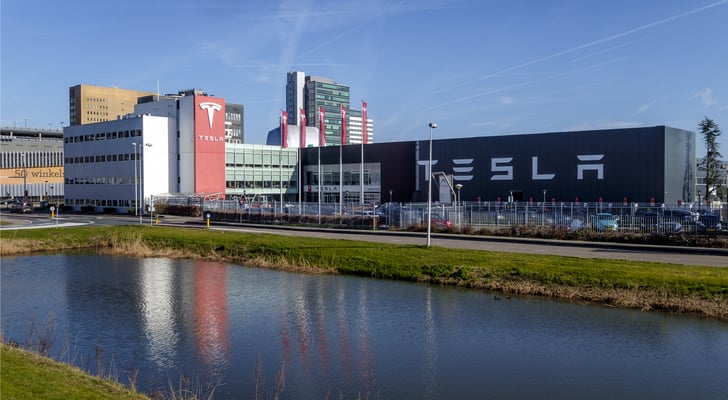When it comes to Tesla (NASDAQ:TSLA) I’ve continually emphasized over the past year that long term investors should see the forest for the trees. The layman’s interpretation of that is that TSLA investors should ignore the near term headlines, and instead focus on the long-running secular trends which ultimately drive Tesla stock price.
When it comes to that forest, there are only three critical long-running trends which matter for Tesla stock. Those three trends can be measured by the following three metrics:
- EV market share as percent of total car sales.
- Tesla market share as a percent total EV sales.
- Tesla’s automotive gross margin.
If you take a deep look at those three critical metrics, the takeaway is broadly bullish for Tesla stock. Indeed, if you take the currently favorable trends in each one of those metrics and optimistically extrapolate them out over the next decade, such modeling will illuminate a pathway for Tesla stock to more than quadruple over the next ten years.
How exactly does Tesla stock get there? Let’s take a deeper look.
EV Market Share Is Roaring Higher
Let’s discuss the first metric, where it is today and where it will be in a decade. There were over 70.8 million new car registrations in the world in 2017. About 1.3 million of those were electric vehicles, meaning EV market share of total vehicle sales in 2017 was about 1.8%.
The EV market has had a robust 2018. Year-to-date through October, roughly 1.5 million EVs have been sold globally. That is up more than 65% year-over-year from last year’s October year-to-date total of roughly 900,000 EVs.
Assuming this growth persists in November and December, the EV market should eclipse 2 million vehicles sold this year. That would represent about 2.8% market share in 2018, up 100 basis points year-over-year.
Clearly, EV market share is on a healthy upward trajectory. This trajectory should continue. As global consumer demand picks up thanks to EV-positive legislation, a larger charging infrastructure, and better vehicles, the EV market will transform into something huge.
We already have a glimpse of what this will look like from Norway, where EV market share has gone from 0% to 30% in a decade
.
The world should easily follow in those footsteps, and global EV market share should head from 2-3% today to 30% by 2028. Assuming mild overall global vehicle growth, that implies somewhere around 25 million EV sales by 2028.
Tesla’s Market Share Is Only Growing
Let’s now discuss the second metric, where it is today, and where it will be in a decade. There were 1.3 million EV deliveries in 2017. About 100,000 of those were Tesla vehicles, giving Tesla an EV market share of roughly 8%.
In 2018, Tesla has accelerated Model 3 production, and in so doing, dramatically increased its market share. Year-to-date through September, the global EV market registered just under 1.3 million vehicle sales.
During that same stretch, Tesla has delivered over 150,000 vehicles. Thus, Tesla’s share of the EV market in 2018 has grown to ~12%, from ~8% last year.
That is healthy growth. And, it’s also surprising. Competition was supposed to knock this company’s market share down as the company grew. Instead, the opposite is happening because of the company’s robust ability to ramp production.
Long term, Tesla market share should inevitably drop as bigger players make bigger moves into the EV space. In 10 years, Tesla’s market share will likely be somewhere between 5% and 15%. On the conservative side, we can call it 7.5%.
A 7.5% share on a global EV market set to do 25 million EV sales in 2028 implies just under 1.9 million Tesla deliveries by then. Assuming an average sales price of $60,000, that would imply automotive revenues of about $115 billion in 10 years.
Gross Margins Are High
Let’s now discuss the third metric, where it is today, and where it will be in a decade. At the end of 2017, Tesla’s automotive gross margin excluding credits was below 15%. At the start of 2018, it moved up to nearly 20%. Last quarter, it was above 25%.
Clearly, gross margins are heading in the right direction as production and delivery scale has increased. That is a positive sign.
So long as gross margins can remain robust and above 25%, Tesla’s overall profitability will improve because revenue scale will drive opex leverage, pull the opex rate way down, and pull up overall net profit margins.
Long term, Tesla thinks 25% total auto gross margins is a reasonable target. Other auto companies operate around 10% opex rates. Thus, operating margins should hover around 15%. On $115 billion in revenues and after factoring in interest expense and taxes, that should flow into about $13 billion in net profits.
Bottom Line on TSLA Stock
If you look at the forest instead of the trees, you will see Tesla as a company with the potential to hit $13 billion in net profits in ten years. Applying a growth average 20 forward multiple to that, you are a looking at a potential 2026 end market cap for Tesla stock of $260 billion.
Tesla’s market cap today is just $60 billion. Thus, Tesla sock has the potential to grow by more than four-fold over the next decade. That makes this stock a long term winner.
As of this writing, Luke Lango was long TSLA.

